
10-Day Romantic Rendezvous in Spain
 10 Day Tour of Barcelona, Madrid and Seville
10 Day Tour of Barcelona, Madrid and Seville
Overview
Trip Map
Itinerary
Inclusions
Reviews







10 Days 9 Nights
Best Time: Jan-Dec
Cultural Exploration
Experiencing the Local Scene
Soak in Spain's culture and nightlife on this 10-day romantic journey through Barcelona, Madrid, and Seville. The handcrafted tour includes private guided tours in each city, including Seville's famed Alcazar palace. You'll also enjoy self-guided tours that take you into the historic hearts of the cities and majestic gothic cathedrals. Savor intimate moments in eclectic neighborhoods, from tapas bars in El Born to romantic dinners by the Seville riverside. Enjoy detailed travel guidance provided by Go Real Travel's mobile app, and focus on cherishing each day with your partner while enjoying Spain to the fullest.
- Stroll through Barcelona's Gothic Quarter, where the streets evoke tales of the medieval past.
- Discover the grandeur of Madrid's Royal Palace and Cathedral..
- Witness the breathtaking beauty of Seville's Royal Alcazar, an architectural masterpiece of history.
- Enjoy a twilight adventure in Barcelona's El Born, savoring tapas in the trendy neighborhood.
- Discover the enchantment of Seville's Santa Cruz, and take in an authentic Flamenco show.
Soak in Spain's culture and nightlife on this 10-day romantic journey through Barcelona, Madrid, and Seville. The handcrafted tour includes private guided tours in each city, including Seville's famed Alcazar palace. You'll also enjoy self-guided tours that take you into the historic hearts of the cities and majestic gothic cathedrals. Savor intimate moments in eclectic neighborhoods, from tapas bars in El Born to romantic dinners by the Seville riverside. Enjoy detailed travel guidance provided by Go Real Travel's mobile app, and focus on cherishing each day with your partner while enjoying Spain to the fullest.
- Stroll through Barcelona's Gothic Quarter, where the streets evoke tales of the medieval past.
- Discover the grandeur of Madrid's Royal Palace and Cathedral..
- Witness the breathtaking beauty of Seville's Royal Alcazar, an architectural masterpiece of history.
- Enjoy a twilight adventure in Barcelona's El Born, savoring tapas in the trendy neighborhood.
- Discover the enchantment of Seville's Santa Cruz, and take in an authentic Flamenco show.

Sagrada Familia
ArchitectureChurches & Monasteries

Park Güell
Parks & Gardens

The Royal Palace
UNESCO World Heritage

Alcazar
UNESCO World Heritage

Seville Cathedral
Churches & Monasteries

Plaza de Espana
Architecture

Santa Cruz
Jewish Heritage

Triana District
Neighborhood

Plaza de Toros
National Site
Must see sights

Sagrada Familia
ArchitectureChurches & Monasteries

Park Güell
Parks & Gardens

The Royal Palace
UNESCO World Heritage

Alcazar
UNESCO World Heritage

Seville Cathedral
Churches & Monasteries

Plaza de Espana
Architecture

Santa Cruz
Jewish Heritage

Triana District
Neighborhood

Plaza de Toros
National Site
Starting from
$2595
per person
 Not included
Not included Secure Your Customizable Trip
Enter your details to embark on a journey that can be tailored just for you.
Start
Travelers
0 travelers
Add Room
Remove Room
Preferred Hotel Stars
Select Hotel Stars
Craft Your Own Itinerary
Select your interests and destinations for a trip plan inspired by you.
Romantic Spain Escape Trip - Map & Itinerary
Enable/Disable Map Scrolling
Click To Make Map Interactive

Romantic Spain Escape Trip Timeline
 Edit Details
Edit DetailsArrival
3 nights
Barcelona
Spain
Train: 3h
3 nights
Madrid
Spain
Train: 3h
3 nights
Seville
Spain
Departure
Day-By-Day Itinerary of Romantic Spain Escape Trip

Day 1
Arrive Barcelona
Day 1
Arrive Barcelona


To Be Determined
Taxi from Airport
Josep Taradellas Barcelona-La Prat is Barcelona's major airport. Taxis to the center of Barcelona should be between 30 to 50€, depending on destination and time of day. Private transfers are available, and Uber and Lyft are available in limited numbers and priced like taxis. There is also a train service direct from Barcelona Sants Train Stayion for budget-minded travelers.

Day 1
Arrive Barcelona


Day 1
Arrive Barcelona



To Be Determined:
Taxi from Airport
Mid-Day to Late Afternoon:
Gothic Quarter


Day 2
Barcelona
Day 2
Barcelona



9:00 AM - 1:00 PM
Barcelona - Medieval & Modernist Tour
Discover the transformation of Barcelona from its Roman roots to a vibrant, modern metropolis, celebrated for its international flair and unique charm. Unveil the secrets of the iconic Sagrada Familia and explore the ancient Roman and medieval quarters. Experience history and architecture come alive through stories, legends, and the expert insights of an Official Barcelona Private Guide. From the majestic Plaça Nova to the historic Jewish Call, embark on a journey through time, punctuated by a delightful break with tea or coffee and churros in a classic café.

Day 2
Barcelona


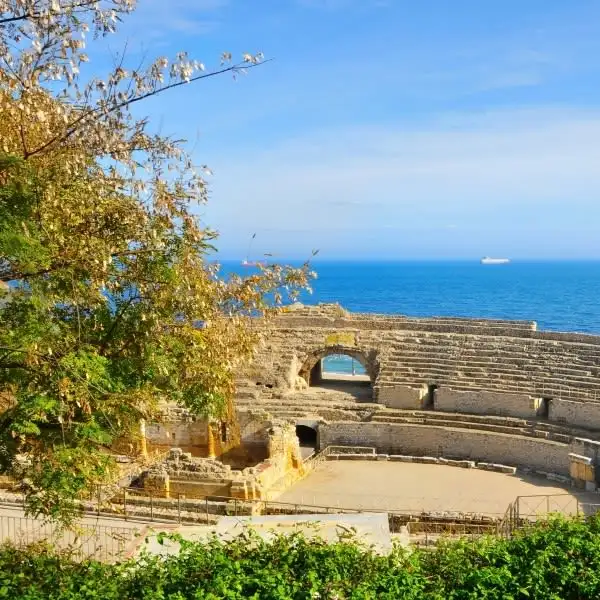
Day 3
Barcelona
Day 3
Barcelona

Early Morning to Early Evening
Excursion to Tarragona
Tarragona, a charming coastal city located just an hour by train from Barcelona, is the perfect day-trip escape for history enthusiasts and beach lovers alike. Known for its well-preserved Roman ruins, this ancient city was once a bustling hub of the Roman Empire. Spend the day exploring the remarkable Roman amphitheater, walking along the ancient city walls, and discovering the remnants of the Forum. Beyond its historical treasures, Tarragona offers stunning Mediterranean beaches and a relaxed seaside atmosphere.

Day 3
Barcelona



Day 4
Barcelona to Madrid
Day 4
Barcelona to Madrid






7:35 AM
Taxi to Rail
Taking a taxi, Uber or Bolt can evade navigating the metro or a bus with luggage. If that sounds attractive, let your hotel confirm a taxi for you; and using the few simple steps below, continue your journey! Most trains to other major cities and international points depart from Barcelona Sants.

Day 4
Barcelona to Madrid



Day 5
Madrid
Day 5
Madrid



9:30 AM - 12:30 PM
Highlights Walking Tour
Immerse yourself in the heart of Spanish history with a captivating 3-hour walking tour in Madrid, focusing on the majestic Royal Palace (exterior) and the bustling Plaza Mayor. At the Royal Palace, you will learn how the Habsburg Empire came to Spain, grew to cover the New World, and then discovered that the Iberian peninsula was enough land. Then, meander toward the vibrant Plaza Mayor, a grand square framed by historic buildings, lively cafes, and street performers. Among the frescos of these Baroque buildings you'll hear Madrid's history, the good and the bad, the everyday and the dramatic. Through it all, you will have the chance to see and hear the buzz of life the proceeds from Spain's capital!

Day 5
Madrid



Day 6
Madrid
Day 6
Madrid


Morning to Afternoon
Excursion to El Escorial
Take a trip into the mountains just outside of Madrid and disover El Escorial. At one time a royal monastery filled with monks praying for the Spanish Empire, El Escorial also served as a royal retreat. Since the king and family slept there, many of the rooms are far from austere. Where once only a precious few could admire the frescos and statues of the largest Renaissance building in the world, you can freely visit!

El Escorial Monastery
The inhabitants were sworn to poverty, the furnishings, not so much.
Show More

La Herrería Forest
Roam the woods and fields of this former royal hunting ground.
Show More

El Escorial Monastery
The inhabitants were sworn to poverty, the furnishings, not so much.
Show More

La Herrería Forest
Roam the woods and fields of this former royal hunting ground.
Show More

El Escorial Monastery
The inhabitants were sworn to poverty, the furnishings, not so much.
Show More

La Herrería Forest
Roam the woods and fields of this former royal hunting ground.
Show More
prev
next

Day 6
Madrid


El Escorial Monastery
 Highlight of Excursion to El Escorial
Highlight of Excursion to El Escorial The inhabitants were sworn to poverty, the furnishings, not so much.
Set in the rugged landscapes of Central Spain, ever turn at El Escorial will awe you. With the Habsburgs running the show in the 16th century, Spain needed a lot of prayers, and the royal family set up this monastery specifically that monks would pray for them. King and family had their spaces too, big ones: it is the largest Renaissance building in the world.

La Herrería Forest
 Highlight of Excursion to El Escorial
Highlight of Excursion to El Escorial Roam the woods and fields of this former royal hunting ground.
There was a time, from 1561 to about 1870, that to be an animal here meant you were a trophy or dinner. The vast royal hunting grounds, of which only La Herrería Forest remain, was the playground of the Spanish King. Nowadays, this undulating landscapes especially protects the large variety of birds that flit through the Pyrenean oak Cherry trees. Deer, the occasional shy bobcat, and even otters grace the landscape, and maybe even they appreciate the stunning views of the El Escorial Monastery.

El Escorial Monastery
 Highlight of Excursion to El Escorial
Highlight of Excursion to El Escorial The inhabitants were sworn to poverty, the furnishings, not so much.
Set in the rugged landscapes of Central Spain, ever turn at El Escorial will awe you. With the Habsburgs running the show in the 16th century, Spain needed a lot of prayers, and the royal family set up this monastery specifically that monks would pray for them. King and family had their spaces too, big ones: it is the largest Renaissance building in the world.

La Herrería Forest
 Highlight of Excursion to El Escorial
Highlight of Excursion to El Escorial Roam the woods and fields of this former royal hunting ground.
There was a time, from 1561 to about 1870, that to be an animal here meant you were a trophy or dinner. The vast royal hunting grounds, of which only La Herrería Forest remain, was the playground of the Spanish King. Nowadays, this undulating landscapes especially protects the large variety of birds that flit through the Pyrenean oak Cherry trees. Deer, the occasional shy bobcat, and even otters grace the landscape, and maybe even they appreciate the stunning views of the El Escorial Monastery.

El Escorial Monastery
 Highlight of Excursion to El Escorial
Highlight of Excursion to El Escorial The inhabitants were sworn to poverty, the furnishings, not so much.
Set in the rugged landscapes of Central Spain, ever turn at El Escorial will awe you. With the Habsburgs running the show in the 16th century, Spain needed a lot of prayers, and the royal family set up this monastery specifically that monks would pray for them. King and family had their spaces too, big ones: it is the largest Renaissance building in the world.

La Herrería Forest
 Highlight of Excursion to El Escorial
Highlight of Excursion to El Escorial Roam the woods and fields of this former royal hunting ground.
There was a time, from 1561 to about 1870, that to be an animal here meant you were a trophy or dinner. The vast royal hunting grounds, of which only La Herrería Forest remain, was the playground of the Spanish King. Nowadays, this undulating landscapes especially protects the large variety of birds that flit through the Pyrenean oak Cherry trees. Deer, the occasional shy bobcat, and even otters grace the landscape, and maybe even they appreciate the stunning views of the El Escorial Monastery.
prev
next


Day 7
Madrid to Seville
Day 7
Madrid to Seville





Morning
Retiro Park
Retiro Park offers an idyllic retreat right amid central Madrid. The expansive green space is more than a park though, it is a part of the city's historical and cultural fabric. Residents and tourists come to relax here, admiring the formal gardens, strolling shaded lanes through manicured forests, and finding a nice spot to picnic near a water feature. Art and architecture are also prominent features of the park, as you can discover in the Palacio de Cristal.

Rosaleda Garden
In Madrid, of Course You Have to Stop and Smell the...
Show More

Puerta de Alcalá
This Granite Arch once guarded the walls of Madrid...
Show More

Fountain of the Fallen Angel
The Fallen Angel statue in El Retiro Park, Madrid, is a striking monument that captures the imagination of visitors. Created by sculptor Ricardo Bellver in 1877, the statue depicts Lucifer falling from Heaven, inspired by John Milton's epic poem "Paradise Lost."
Show More

Palacio de Cristal
Feel Genteel next to This Monument of 19th-Century Spanish Industry
Show More

Estanque Grande
Row Your Worries Away on the Grand Water of El Retiro Park
Show More

Rosaleda Garden
In Madrid, of Course You Have to Stop and Smell the...
Show More

Puerta de Alcalá
This Granite Arch once guarded the walls of Madrid...
Show More

Fountain of the Fallen Angel
The Fallen Angel statue in El Retiro Park, Madrid, is a striking monument that captures the imagination of visitors. Created by sculptor Ricardo Bellver in 1877, the statue depicts Lucifer falling from Heaven, inspired by John Milton's epic poem "Paradise Lost."
Show More

Palacio de Cristal
Feel Genteel next to This Monument of 19th-Century Spanish Industry
Show More

Estanque Grande
Row Your Worries Away on the Grand Water of El Retiro Park
Show More

Rosaleda Garden
In Madrid, of Course You Have to Stop and Smell the...
Show More
prev
next

Day 7
Madrid to Seville


Rosaleda Garden
 Highlight of Retiro Park
Highlight of Retiro ParkIn Madrid, of Course You Have to Stop and Smell the...
...Rosaleda garden in Retiro Park, featuring over 4,000 varieties of roses from around the world. With over 100 years of tradition meticulously maintaining this garden, it bursts into vibrant colors and fragrances from spring through fall, offering a fragrant and sensual experience to visitors wise or lucky enough to walk through the garden. The annual rose competition held here highlights the garden's significance in the world of horticulture, but be warned, the competition can get thorny.

Puerta de Alcalá
 Highlight of Retiro Park
Highlight of Retiro ParkThis Granite Arch once guarded the walls of Madrid...
The Puerta de Alcalá stands as a monumental gateway to Madrid. Erected in 1778, this neoclassical archway, the first of its kind since ancient Rome, was a symbol of modernity and rational society. The city has long expanded beyond the gate, and now serves as an entry marking one of Madrid's greatest treasures - Retiro Park.
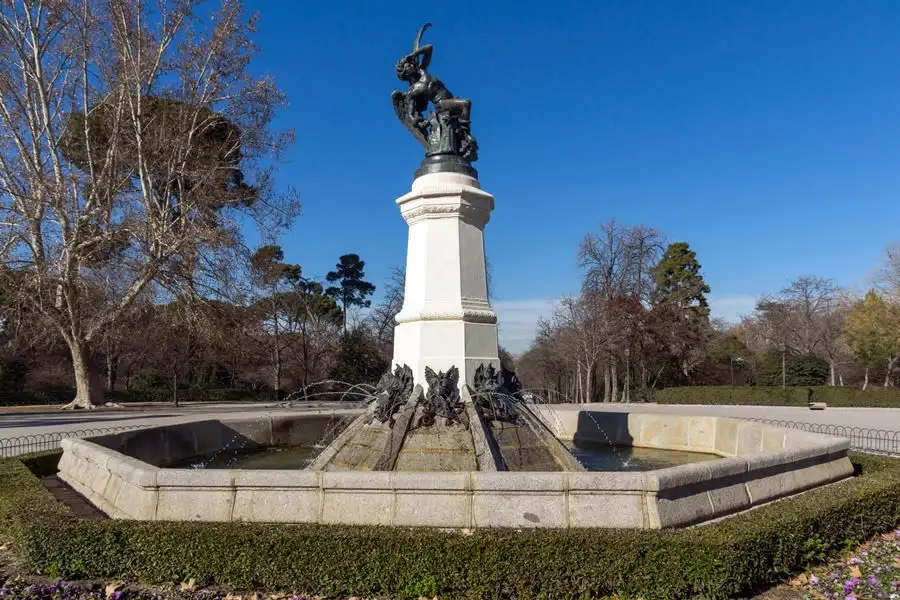
Fountain of the Fallen Angel
 Highlight of Retiro Park
Highlight of Retiro ParkThe Fallen Angel statue in El Retiro Park, Madrid, is a striking monument that captures the imagination of visitors. Created by sculptor Ricardo Bellver in 1877, the statue depicts Lucifer falling from Heaven, inspired by John Milton's epic poem "Paradise Lost."
The Fallen Angel statue in Madrid's El Retiro Park is a captivating and enigmatic sculpture by Ricardo Bellver, completed in 1877. Depicting Lucifer in his moment of downfall, the statue is inspired by John Milton's "Paradise Lost" and stands atop a dramatic pedestal adorned with sinister figures and ornate details. This monument is unique for its rare subject matter, being one of the few public statues in the world dedicated to the figure of a fallen angel. Nestled in the verdant surroundings of El Retiro, the statue offers an intriguing contrast to the park's tranquility, making it a fascinating highlight for visitors.

Palacio de Cristal
 Highlight of Retiro Park
Highlight of Retiro ParkFeel Genteel next to This Monument of 19th-Century Spanish Industry
The Palacio de Cristal, a stunning and early example of glass and iron architecture, was built in 1887 within Madrid's Retiro Park. Originally a greenhouse, it now serves as an exquisite extension of the Reina Sofia Art Museum. Surrounded by lush gardens and a small lake mirroring its structure, the Palacio evokes a cultured and sophisticated past... and a pleasant present.

Estanque Grande
 Highlight of Retiro Park
Highlight of Retiro ParkRow Your Worries Away on the Grand Water of El Retiro Park
The Estanque Grande, Retiro Park's grand lake, offers an aqueous view of the park. Visitors can rent rowboats and glide across the tranquil waters with the magnificent Monument to Alfonso XII as a backdrop. The relaxation and romance of this languid space makes it a favorite for couples, familes, and anyone looking for a moment of peace on the water.

Rosaleda Garden
 Highlight of Retiro Park
Highlight of Retiro ParkIn Madrid, of Course You Have to Stop and Smell the...
...Rosaleda garden in Retiro Park, featuring over 4,000 varieties of roses from around the world. With over 100 years of tradition meticulously maintaining this garden, it bursts into vibrant colors and fragrances from spring through fall, offering a fragrant and sensual experience to visitors wise or lucky enough to walk through the garden. The annual rose competition held here highlights the garden's significance in the world of horticulture, but be warned, the competition can get thorny.

Puerta de Alcalá
 Highlight of Retiro Park
Highlight of Retiro ParkThis Granite Arch once guarded the walls of Madrid...
The Puerta de Alcalá stands as a monumental gateway to Madrid. Erected in 1778, this neoclassical archway, the first of its kind since ancient Rome, was a symbol of modernity and rational society. The city has long expanded beyond the gate, and now serves as an entry marking one of Madrid's greatest treasures - Retiro Park.

Fountain of the Fallen Angel
 Highlight of Retiro Park
Highlight of Retiro ParkThe Fallen Angel statue in El Retiro Park, Madrid, is a striking monument that captures the imagination of visitors. Created by sculptor Ricardo Bellver in 1877, the statue depicts Lucifer falling from Heaven, inspired by John Milton's epic poem "Paradise Lost."
The Fallen Angel statue in Madrid's El Retiro Park is a captivating and enigmatic sculpture by Ricardo Bellver, completed in 1877. Depicting Lucifer in his moment of downfall, the statue is inspired by John Milton's "Paradise Lost" and stands atop a dramatic pedestal adorned with sinister figures and ornate details. This monument is unique for its rare subject matter, being one of the few public statues in the world dedicated to the figure of a fallen angel. Nestled in the verdant surroundings of El Retiro, the statue offers an intriguing contrast to the park's tranquility, making it a fascinating highlight for visitors.

Palacio de Cristal
 Highlight of Retiro Park
Highlight of Retiro ParkFeel Genteel next to This Monument of 19th-Century Spanish Industry
The Palacio de Cristal, a stunning and early example of glass and iron architecture, was built in 1887 within Madrid's Retiro Park. Originally a greenhouse, it now serves as an exquisite extension of the Reina Sofia Art Museum. Surrounded by lush gardens and a small lake mirroring its structure, the Palacio evokes a cultured and sophisticated past... and a pleasant present.

Estanque Grande
 Highlight of Retiro Park
Highlight of Retiro ParkRow Your Worries Away on the Grand Water of El Retiro Park
The Estanque Grande, Retiro Park's grand lake, offers an aqueous view of the park. Visitors can rent rowboats and glide across the tranquil waters with the magnificent Monument to Alfonso XII as a backdrop. The relaxation and romance of this languid space makes it a favorite for couples, familes, and anyone looking for a moment of peace on the water.

Rosaleda Garden
 Highlight of Retiro Park
Highlight of Retiro ParkIn Madrid, of Course You Have to Stop and Smell the...
...Rosaleda garden in Retiro Park, featuring over 4,000 varieties of roses from around the world. With over 100 years of tradition meticulously maintaining this garden, it bursts into vibrant colors and fragrances from spring through fall, offering a fragrant and sensual experience to visitors wise or lucky enough to walk through the garden. The annual rose competition held here highlights the garden's significance in the world of horticulture, but be warned, the competition can get thorny.
prev
next

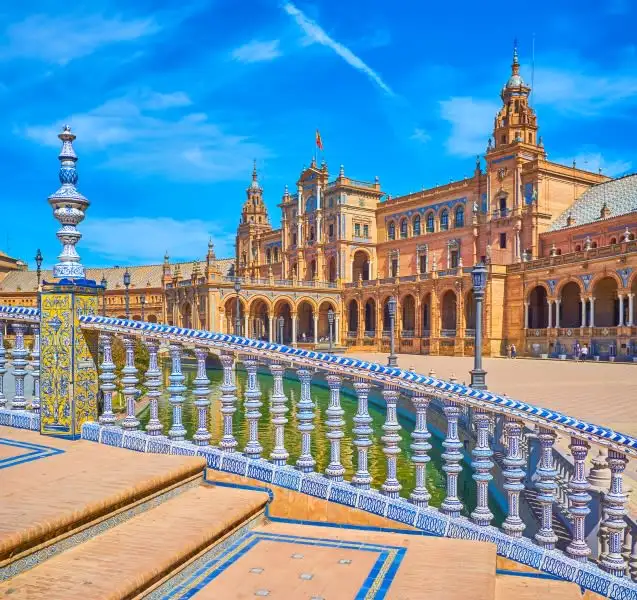
Day 8
Seville
Day 8
Seville



9:00 AM - 12:30 PM
Guided Highlights & Alcazar
Walk with your private guide and discover the long, eventful history of Seville. From Roman walls built at the command of Julius Caesar to the Royal Alcazar Palace of the Caliphs, from and St. Mary's Cathedral, a repurposed mosque, to the General Archive ofthe Indies containing the early records of New World exploration, this tour will amaze you. Your guide will help you skip the lines for the Alcazar, one of the triumphs of Moorish architecture, to illustrate the many winds of history that have blown through Seville's streets.

Seville Alcazar
The Seville Alcázar, a UNESCO World Heritage site, is a stunning blend of Mudéjar, Gothic, Renaissance, and Baroque architecture. Originally a 10th-century fortress, it features the exquisite Patio de las Doncellas, the grand Salón de Embajadores, and lush, expansive gardens.
Show More

Seville Alcazar
The Seville Alcázar, a UNESCO World Heritage site, is a stunning blend of Mudéjar, Gothic, Renaissance, and Baroque architecture. Originally a 10th-century fortress, it features the exquisite Patio de las Doncellas, the grand Salón de Embajadores, and lush, expansive gardens.
Show More

Seville Alcazar
The Seville Alcázar, a UNESCO World Heritage site, is a stunning blend of Mudéjar, Gothic, Renaissance, and Baroque architecture. Originally a 10th-century fortress, it features the exquisite Patio de las Doncellas, the grand Salón de Embajadores, and lush, expansive gardens.
Show More

Seville Alcazar
The Seville Alcázar, a UNESCO World Heritage site, is a stunning blend of Mudéjar, Gothic, Renaissance, and Baroque architecture. Originally a 10th-century fortress, it features the exquisite Patio de las Doncellas, the grand Salón de Embajadores, and lush, expansive gardens.
Show More

Seville Alcazar
The Seville Alcázar, a UNESCO World Heritage site, is a stunning blend of Mudéjar, Gothic, Renaissance, and Baroque architecture. Originally a 10th-century fortress, it features the exquisite Patio de las Doncellas, the grand Salón de Embajadores, and lush, expansive gardens.
Show More
prev
next

Day 8
Seville

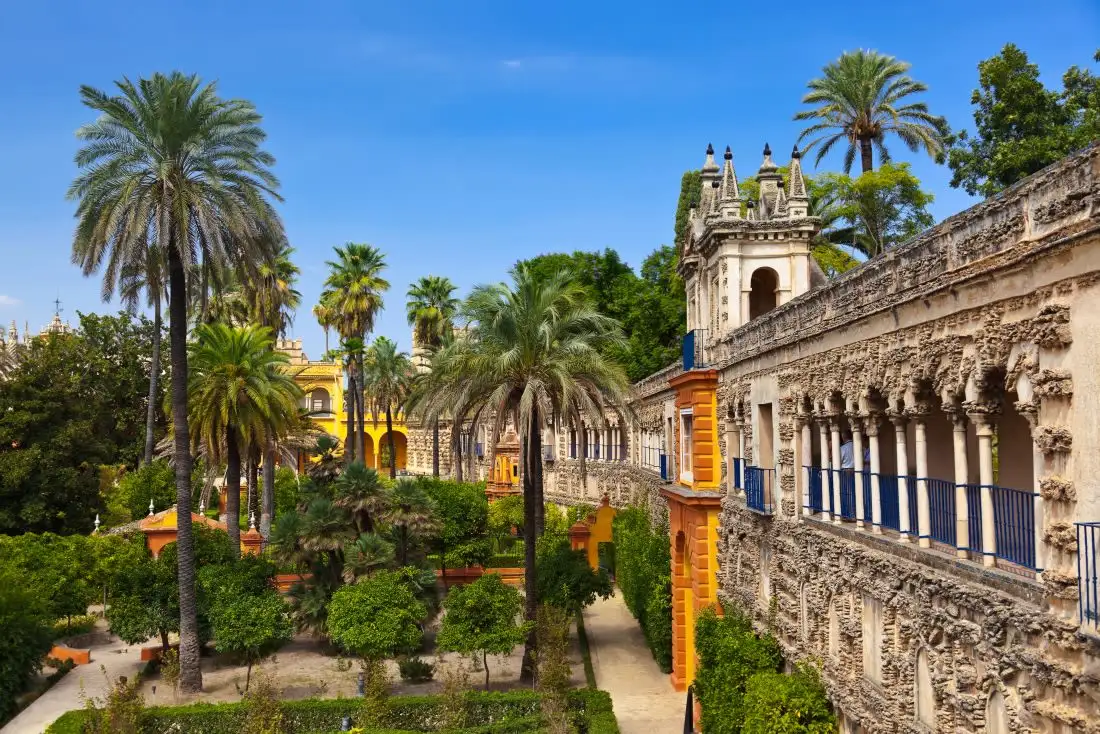
Seville Alcazar
 Highlight of Guided Highlights & Alcazar
Highlight of Guided Highlights & AlcazarThe Seville Alcázar, a UNESCO World Heritage site, is a stunning blend of Mudéjar, Gothic, Renaissance, and Baroque architecture. Originally a 10th-century fortress, it features the exquisite Patio de las Doncellas, the grand Salón de Embajadores, and lush, expansive gardens.
The Seville Alcázar, a UNESCO World Heritage site, stands as a testament to Spain's rich cultural history and architectural prowess. Originally built in the 10th century as a fortress for the Cordoban governors of Seville, the Alcázar was later transformed into a magnificent royal palace. This evolution resulted in a unique blend of Mudéjar, Gothic, Renaissance, and Baroque styles, creating a visually stunning and historically significant monument. Visitors can explore the enchanting Patio de las Doncellas, a courtyard renowned for its intricate tilework and lush greenery. The Salón de Embajadores, once the site of grand state affairs, dazzles with its elaborate decoration and regal ambiance. The Alcázar's expansive gardens are a highlight, featuring tranquil fountains, fragrant orange trees, and meticulously maintained landscapes. These gardens offer a serene escape and a vivid glimpse into the luxurious lifestyles of Spain's Moorish and Christian rulers.

Seville Alcazar
 Highlight of Guided Highlights & Alcazar
Highlight of Guided Highlights & AlcazarThe Seville Alcázar, a UNESCO World Heritage site, is a stunning blend of Mudéjar, Gothic, Renaissance, and Baroque architecture. Originally a 10th-century fortress, it features the exquisite Patio de las Doncellas, the grand Salón de Embajadores, and lush, expansive gardens.
The Seville Alcázar, a UNESCO World Heritage site, stands as a testament to Spain's rich cultural history and architectural prowess. Originally built in the 10th century as a fortress for the Cordoban governors of Seville, the Alcázar was later transformed into a magnificent royal palace. This evolution resulted in a unique blend of Mudéjar, Gothic, Renaissance, and Baroque styles, creating a visually stunning and historically significant monument. Visitors can explore the enchanting Patio de las Doncellas, a courtyard renowned for its intricate tilework and lush greenery. The Salón de Embajadores, once the site of grand state affairs, dazzles with its elaborate decoration and regal ambiance. The Alcázar's expansive gardens are a highlight, featuring tranquil fountains, fragrant orange trees, and meticulously maintained landscapes. These gardens offer a serene escape and a vivid glimpse into the luxurious lifestyles of Spain's Moorish and Christian rulers.

Seville Alcazar
 Highlight of Guided Highlights & Alcazar
Highlight of Guided Highlights & AlcazarThe Seville Alcázar, a UNESCO World Heritage site, is a stunning blend of Mudéjar, Gothic, Renaissance, and Baroque architecture. Originally a 10th-century fortress, it features the exquisite Patio de las Doncellas, the grand Salón de Embajadores, and lush, expansive gardens.
The Seville Alcázar, a UNESCO World Heritage site, stands as a testament to Spain's rich cultural history and architectural prowess. Originally built in the 10th century as a fortress for the Cordoban governors of Seville, the Alcázar was later transformed into a magnificent royal palace. This evolution resulted in a unique blend of Mudéjar, Gothic, Renaissance, and Baroque styles, creating a visually stunning and historically significant monument. Visitors can explore the enchanting Patio de las Doncellas, a courtyard renowned for its intricate tilework and lush greenery. The Salón de Embajadores, once the site of grand state affairs, dazzles with its elaborate decoration and regal ambiance. The Alcázar's expansive gardens are a highlight, featuring tranquil fountains, fragrant orange trees, and meticulously maintained landscapes. These gardens offer a serene escape and a vivid glimpse into the luxurious lifestyles of Spain's Moorish and Christian rulers.

Seville Alcazar
 Highlight of Guided Highlights & Alcazar
Highlight of Guided Highlights & AlcazarThe Seville Alcázar, a UNESCO World Heritage site, is a stunning blend of Mudéjar, Gothic, Renaissance, and Baroque architecture. Originally a 10th-century fortress, it features the exquisite Patio de las Doncellas, the grand Salón de Embajadores, and lush, expansive gardens.
The Seville Alcázar, a UNESCO World Heritage site, stands as a testament to Spain's rich cultural history and architectural prowess. Originally built in the 10th century as a fortress for the Cordoban governors of Seville, the Alcázar was later transformed into a magnificent royal palace. This evolution resulted in a unique blend of Mudéjar, Gothic, Renaissance, and Baroque styles, creating a visually stunning and historically significant monument. Visitors can explore the enchanting Patio de las Doncellas, a courtyard renowned for its intricate tilework and lush greenery. The Salón de Embajadores, once the site of grand state affairs, dazzles with its elaborate decoration and regal ambiance. The Alcázar's expansive gardens are a highlight, featuring tranquil fountains, fragrant orange trees, and meticulously maintained landscapes. These gardens offer a serene escape and a vivid glimpse into the luxurious lifestyles of Spain's Moorish and Christian rulers.

Seville Alcazar
 Highlight of Guided Highlights & Alcazar
Highlight of Guided Highlights & AlcazarThe Seville Alcázar, a UNESCO World Heritage site, is a stunning blend of Mudéjar, Gothic, Renaissance, and Baroque architecture. Originally a 10th-century fortress, it features the exquisite Patio de las Doncellas, the grand Salón de Embajadores, and lush, expansive gardens.
The Seville Alcázar, a UNESCO World Heritage site, stands as a testament to Spain's rich cultural history and architectural prowess. Originally built in the 10th century as a fortress for the Cordoban governors of Seville, the Alcázar was later transformed into a magnificent royal palace. This evolution resulted in a unique blend of Mudéjar, Gothic, Renaissance, and Baroque styles, creating a visually stunning and historically significant monument. Visitors can explore the enchanting Patio de las Doncellas, a courtyard renowned for its intricate tilework and lush greenery. The Salón de Embajadores, once the site of grand state affairs, dazzles with its elaborate decoration and regal ambiance. The Alcázar's expansive gardens are a highlight, featuring tranquil fountains, fragrant orange trees, and meticulously maintained landscapes. These gardens offer a serene escape and a vivid glimpse into the luxurious lifestyles of Spain's Moorish and Christian rulers.
prev
next


Day 9
Seville
Day 9
Seville


Morning/Mid-Day
Casco Antiguo Norte
The northern part of Seville's Casco Antiguo (Old Town) offers captivating historical attractions as well as a strikingly modern landmark in the Setas de Sevilla. This area, with its mix of cultural landmarks and lively atmosphere, provides a unique perspective on Seville's heritage, while also offering a glimpse into the city's life beyond the most touristed quarters. For instance, this is where you'll find the Alameda de Hércules, a vibrant boulevard filled with cafes and nightlife, where the locals often head for an evening out on the town. You can explore two of Seville's most beautiful architectural masterpieces, the majestic Duenas Palace with its rich history and stunning gardens, and the Casa de Pilatos, which is a showcase for exquisite architecture and art. Art lovers should also not miss the Museum of Fine Arts for an impressive array of Spanish masterpieces. For some visitors, the highlight of their visit to the city is the contemporary Setas de Sevilla, also known as the Metropol Parasol. It offers panoramic views and a glimpse into Seville's innovative spirit.

Alameda de Hércules
Stroll a lively and wide boulevard that is also Seville's oldest public garden.
Show More

Casa de Pilatos
Tour one of Seville's most magnificent architectural gems, the Casa de Pilatos.
Show More

Museum of Fine Arts
Admire Spanish masterpieces at the Museum of Fine Arts.
Show More

Setas de Sevilla
Walk above the rooftops of Seville on this strikingly modern wooden parasol.
Show More

Duenas Palace
Explore the lavish Duenas Palace and its breathtaking gardens.
Show More

Alameda de Hércules
Stroll a lively and wide boulevard that is also Seville's oldest public garden.
Show More

Casa de Pilatos
Tour one of Seville's most magnificent architectural gems, the Casa de Pilatos.
Show More

Museum of Fine Arts
Admire Spanish masterpieces at the Museum of Fine Arts.
Show More

Setas de Sevilla
Walk above the rooftops of Seville on this strikingly modern wooden parasol.
Show More

Duenas Palace
Explore the lavish Duenas Palace and its breathtaking gardens.
Show More

Alameda de Hércules
Stroll a lively and wide boulevard that is also Seville's oldest public garden.
Show More
prev
next

Day 9
Seville

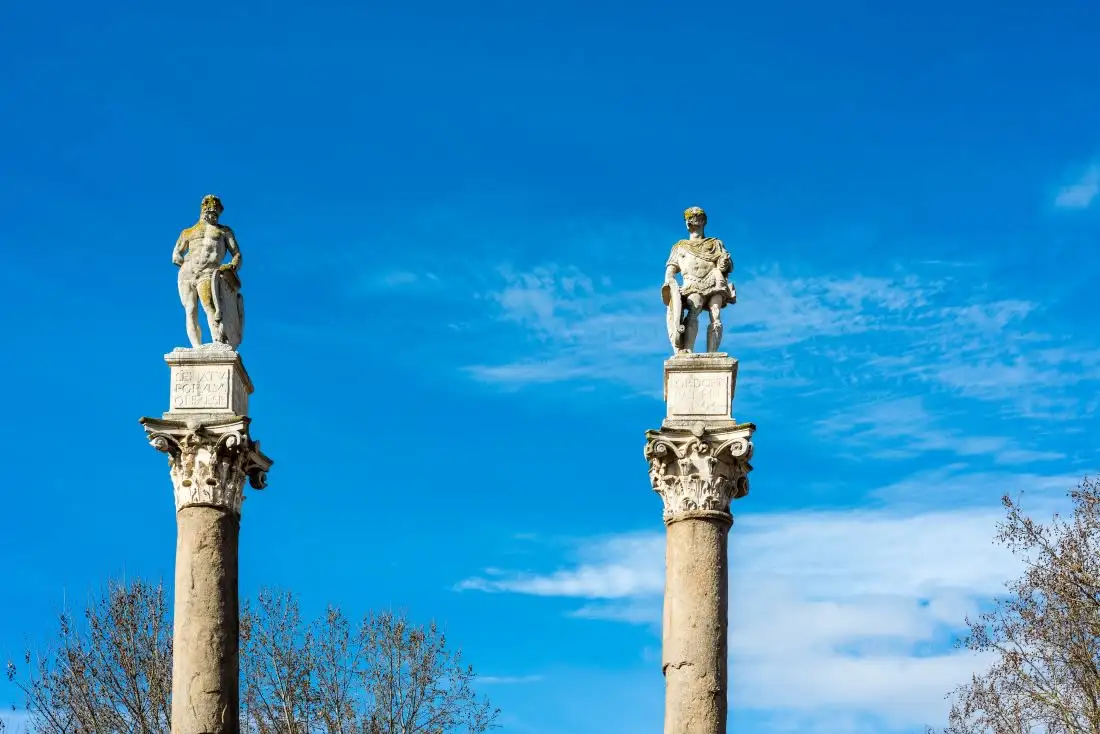
Alameda de Hércules
 Highlight of Casco Antiguo Norte
Highlight of Casco Antiguo NorteStroll a lively and wide boulevard that is also Seville's oldest public garden.
The Alameda de Hércules is a lively boulevard is adorned with Roman columns and statues of Hercules and is a hub of local culture and nightlife. It was established in 1574 as Seville's oldest public garden, but today it's an ideal spot to experience the city's vibrant social scene amidst locals and to enjoy various cafes and bars.

Casa de Pilatos
 Highlight of Casco Antiguo Norte
Highlight of Casco Antiguo NorteTour one of Seville's most magnificent architectural gems, the Casa de Pilatos.
The splendid Casa de Pilatos is a 16th-century palace renowned for its exquisite Mudéjar, Gothic, and Renaissance architectural elements. The palace features a stunning courtyard, richly decorated rooms, and a remarkable collection of ancient artifacts and artworks. It's a masterpiece of Seville's architectural heritage.

Museum of Fine Arts
 Highlight of Casco Antiguo Norte
Highlight of Casco Antiguo NorteAdmire Spanish masterpieces at the Museum of Fine Arts.
The Museum of Fine Arts' extensive collection of Spanish art is housed in a former convent. Established in 1839, the museum boasts works by renowned artists such as Murillo, Zurbarán, and Goya. The 17th-century building itself is a beautiful example of Baroque architecture, with tranquil courtyards and ornate interiors.

Setas de Sevilla
 Highlight of Casco Antiguo Norte
Highlight of Casco Antiguo NorteWalk above the rooftops of Seville on this strikingly modern wooden parasol.
Discover the contemporary Metropol Parasol, also known as "Las Setas," a striking wooden structure that offers panoramic views of Seville and covers one of the city's main squares. Completed in 2011, it features a lively market, archaeological museum, and rooftop walkway. It's a modern architectural icon blending history and innovation in the heart of the city.

Duenas Palace
 Highlight of Casco Antiguo Norte
Highlight of Casco Antiguo NorteExplore the lavish Duenas Palace and its breathtaking gardens.
Although overshadowed by the Royal Alcazar and Casa de Pilatos, you may find the opulent Duenas Palace is your favorite place in Seville. The palace is a stunning example of Andalusian architecture with beautiful gardens, an excellent art collection, and an interesting history that dates back to the 15th century. This palace, once home to the Duchess of Alba, showcases a mix of Renaissance, Gothic, and Moorish styles that are not only beautiful, but perfectly preserved, creating a magical setting.

Alameda de Hércules
 Highlight of Casco Antiguo Norte
Highlight of Casco Antiguo NorteStroll a lively and wide boulevard that is also Seville's oldest public garden.
The Alameda de Hércules is a lively boulevard is adorned with Roman columns and statues of Hercules and is a hub of local culture and nightlife. It was established in 1574 as Seville's oldest public garden, but today it's an ideal spot to experience the city's vibrant social scene amidst locals and to enjoy various cafes and bars.

Casa de Pilatos
 Highlight of Casco Antiguo Norte
Highlight of Casco Antiguo NorteTour one of Seville's most magnificent architectural gems, the Casa de Pilatos.
The splendid Casa de Pilatos is a 16th-century palace renowned for its exquisite Mudéjar, Gothic, and Renaissance architectural elements. The palace features a stunning courtyard, richly decorated rooms, and a remarkable collection of ancient artifacts and artworks. It's a masterpiece of Seville's architectural heritage.

Museum of Fine Arts
 Highlight of Casco Antiguo Norte
Highlight of Casco Antiguo NorteAdmire Spanish masterpieces at the Museum of Fine Arts.
The Museum of Fine Arts' extensive collection of Spanish art is housed in a former convent. Established in 1839, the museum boasts works by renowned artists such as Murillo, Zurbarán, and Goya. The 17th-century building itself is a beautiful example of Baroque architecture, with tranquil courtyards and ornate interiors.

Setas de Sevilla
 Highlight of Casco Antiguo Norte
Highlight of Casco Antiguo NorteWalk above the rooftops of Seville on this strikingly modern wooden parasol.
Discover the contemporary Metropol Parasol, also known as "Las Setas," a striking wooden structure that offers panoramic views of Seville and covers one of the city's main squares. Completed in 2011, it features a lively market, archaeological museum, and rooftop walkway. It's a modern architectural icon blending history and innovation in the heart of the city.

Duenas Palace
 Highlight of Casco Antiguo Norte
Highlight of Casco Antiguo NorteExplore the lavish Duenas Palace and its breathtaking gardens.
Although overshadowed by the Royal Alcazar and Casa de Pilatos, you may find the opulent Duenas Palace is your favorite place in Seville. The palace is a stunning example of Andalusian architecture with beautiful gardens, an excellent art collection, and an interesting history that dates back to the 15th century. This palace, once home to the Duchess of Alba, showcases a mix of Renaissance, Gothic, and Moorish styles that are not only beautiful, but perfectly preserved, creating a magical setting.

Alameda de Hércules
 Highlight of Casco Antiguo Norte
Highlight of Casco Antiguo NorteStroll a lively and wide boulevard that is also Seville's oldest public garden.
The Alameda de Hércules is a lively boulevard is adorned with Roman columns and statues of Hercules and is a hub of local culture and nightlife. It was established in 1574 as Seville's oldest public garden, but today it's an ideal spot to experience the city's vibrant social scene amidst locals and to enjoy various cafes and bars.
prev
next


Day 10
Depart Seville
Day 10
Depart Seville

To Be Determined
Taxi to Airport
The Aeropuerto de Seville rests about a 15-minute taxi ride from town (depending on your precise location). If you leave from your hotel 2 hours and 45 minutes before your flight, you should have a good amount of time to deposit bags and pass through security. In heavy traffic, the ride can last up to 40 mins. Depending on time of day, the ride will cost between 30 and 45 euros. Uber has a limited presence in Seville, but it is available.

Day 10
Depart Seville


What's Included In Romantic Spain Escape Trip

Pre-Paid Tours and Activities:
- Medieval & Modernist, the Highlights of Barcelona Tour
- Highlights of Madrid Private Walking Tour
- Guided Tour of the Highlights of Seville including the Royal Alcazar
- City Card for Barcelona, including discounts to many popular attractions

Pre-Paid Transportation:
- 2nd Class Train Tickets from Barcelona Sants to Madrid-Puerta de Atocha
- 2nd Class Train Tickets from Madrid-Puerta de Atocha to Sevilla Santa Justa
- Public Transport Tickets for Barcelona

Accommodation:
- 3 nights at a hotel of your choice in Barcelona
- 3 nights at a hotel of your choice in Madrid
- 3 nights at a hotel of your choice in Seville

Go Real Travel Mobile App:
- Itinerary Plan & Reservations Info
- Points of Interest
- Detailed Travel Information
- Maps & Directions
Other Trips You May Like

14 Days
From$3679USD

15 Days
From$3832USD

5 Days
From$1699USD

4 Days
From$1100USD

10 Days
From$2890USD

21 Days
From$4999USD

7 Days
From$1725USD

10 Days
From$2599USD

15 Days
From$5274USD
Southern European Treasures: A 15-Day Cultural Odyssey in Portugal, Spain & Italy

Portugal, Spain, Italy

14 Days
From$3679USD

15 Days
From$3832USD

5 Days
From$1699USD

4 Days
From$1100USD

10 Days
From$2890USD

21 Days
From$4999USD

7 Days
From$1725USD

10 Days
From$2599USD

15 Days
From$5274USD
Southern European Treasures: A 15-Day Cultural Odyssey in Portugal, Spain & Italy

Portugal, Spain, Italy
prev
next
Featured Blogs
prev
next
Our Customers Say It Best
Marianne Strydom, Paarl, South Africa
I just wanted to thank you for organizing an amazing trip for me – I packed in so much in such a short period of time and everything was just perfect. The way you do things makes it possible to really get to know the destination, which for me as a travel agent could not have been better. 

Otto Chuy, Los Angeles, California
I am still surprised how everything worked as planned, without a hitch. All instructions in your itinerary were precise and correct. Your suggestions and comments in each of the locations we went to were very helpful. All your guides, without exception, were wonderful and exactly on time. 

Malini Dutta, Boston, Massachusetts
We can't thank you enough for the detailed plans, maps, and suggestions. It really felt that someone was holding our hands and showing us around. We had all the excitement of discovering foreign lands, with none of the problems that can happen while negotiating unfamiliar places. In fact, all the cities felt like home within a few hours of arriving and exploring. 

Bev and Mark Frankel, Williamsburg, Virginia
We could not be more pleased with Go Real Travel! You took the guess work out of things like public transport but still managed to allow us the freedom to tour as we wanted. Our guides were exceptional and every time I saw a Viking Cruise tour of 25 people, I realized the quality experience we were getting with Go Real. 

Marianne Strydom, Paarl, South Africa
I just wanted to thank you for organizing an amazing trip for me – I packed in so much in such a short period of time and everything was just perfect. The way you do things makes it possible to really get to know the destination, which for me as a travel agent could not have been better. 

Otto Chuy, Los Angeles, California
I am still surprised how everything worked as planned, without a hitch. All instructions in your itinerary were precise and correct. Your suggestions and comments in each of the locations we went to were very helpful. All your guides, without exception, were wonderful and exactly on time. 

Malini Dutta, Boston, Massachusetts
We can't thank you enough for the detailed plans, maps, and suggestions. It really felt that someone was holding our hands and showing us around. We had all the excitement of discovering foreign lands, with none of the problems that can happen while negotiating unfamiliar places. In fact, all the cities felt like home within a few hours of arriving and exploring. 

Bev and Mark Frankel, Williamsburg, Virginia
We could not be more pleased with Go Real Travel! You took the guess work out of things like public transport but still managed to allow us the freedom to tour as we wanted. Our guides were exceptional and every time I saw a Viking Cruise tour of 25 people, I realized the quality experience we were getting with Go Real. 



Explore cities in more detail
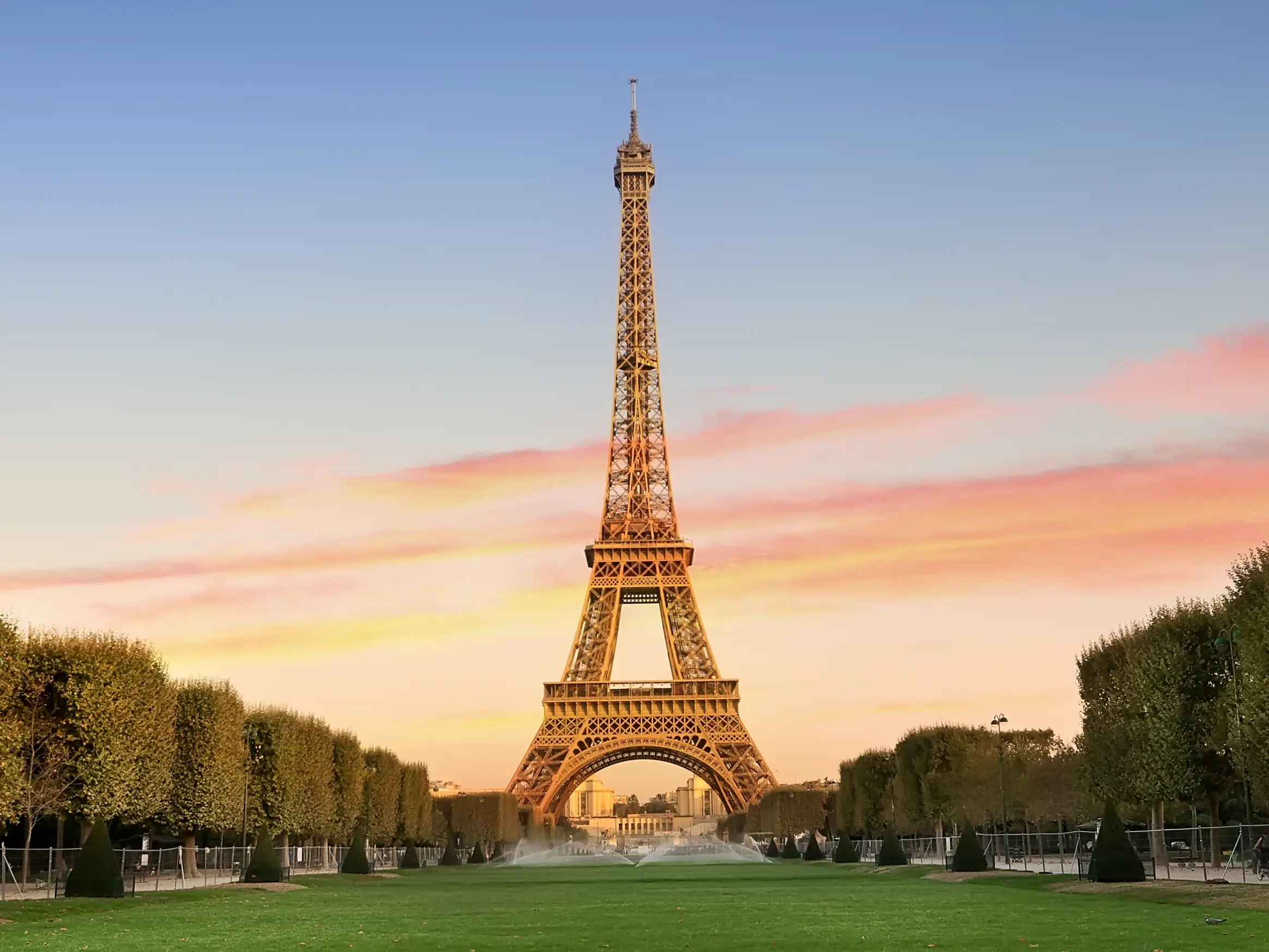
Paris
The magic of Paris is undeniable. This is the most romantic destination in Europe, and surely the number one bucket list destination of all time. If you want to say you've traveled, you have to visit Paris at least once. Along with classic must-sees like the Eiffel Tower and the Sacre-Coeur, there is so much to see and do in Paris that it helps to narrow it down by interest. Fashion and shopping enthusiast? Look no further than the Galeries Lafayette, Avenue des Champs-Élysées, or the Marais. Art aficionado? Once you're done with the Louvre, make a start on the Musée d'Orsay. History buffs won't be able to walk a block without uncovering a monument to Napoleon or Louis XIV. If you visit Paris with a foodie, be warned — you'll gaze in a lot of patisserie windows, and sample your weight in croissants. Because Paris always has so much on offer, it never grows old. At dusk, as you stroll the wide boulevards past Haussmann apartment buildings and sharply dressed Parisians, or gaze down at the city from the hill at Montmarte, you might find yourself saying 'Paris Je t' aime'. This is, after all, the City of Love.

Learn About Paris
Build Paris Trip
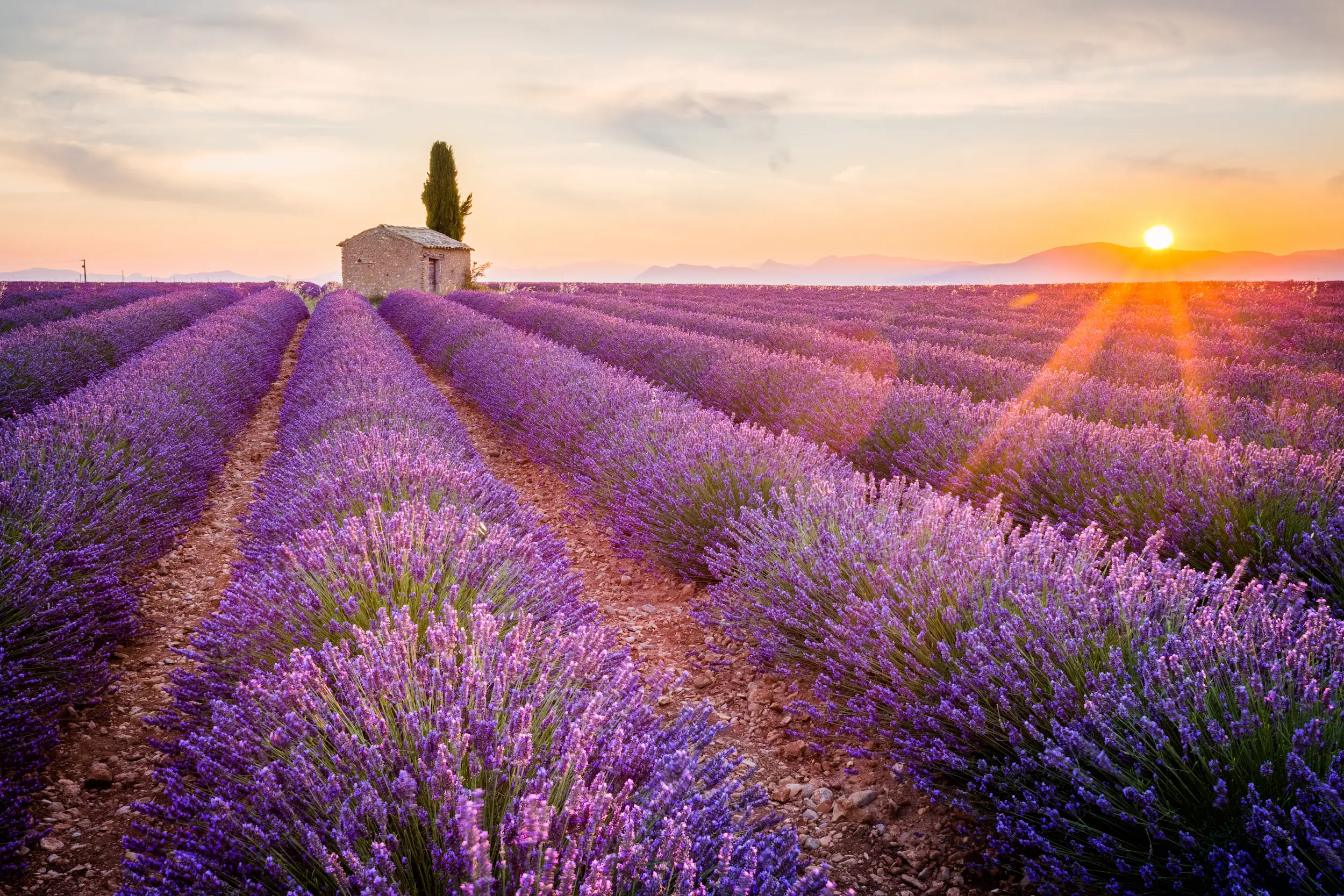
Aix en Provence
Aix en Provence is a warm city baked into the Provence-Alpes-Côte region of Southern France. Often referred to as simply ‘Aix’, this city is a starting point for traveling the Provencal region. Aix is set amongst a backdrop of rambling vineyards, quaint villages, and the imposing Sainte-Victoire mountain range. It’s no surprise that artists like Cézanne have devoted lifetimes to painting this landscape. Aromatic lavender fields in the north blossom once a year with a scent that defines the French countryside. Head south and you’ll find the rocky Mediterranean shore with dramatic Calanques cliffs and clear blue waters. With the sun out nearly all year round, locals live the epitome of the Mediterranean lifestyle. Wander through narrow medieval streets, shop at lively marketplaces, and enjoy a glass of rosé on a cafe terrace beneath the gentle Provencal sun. From old-world architecture and bubbling fountains to refined galleries and leafy parks, this leisurely city has everything you could ask of a French vacation.

Learn About Aix en Provence
Build Aix en Provence Trip
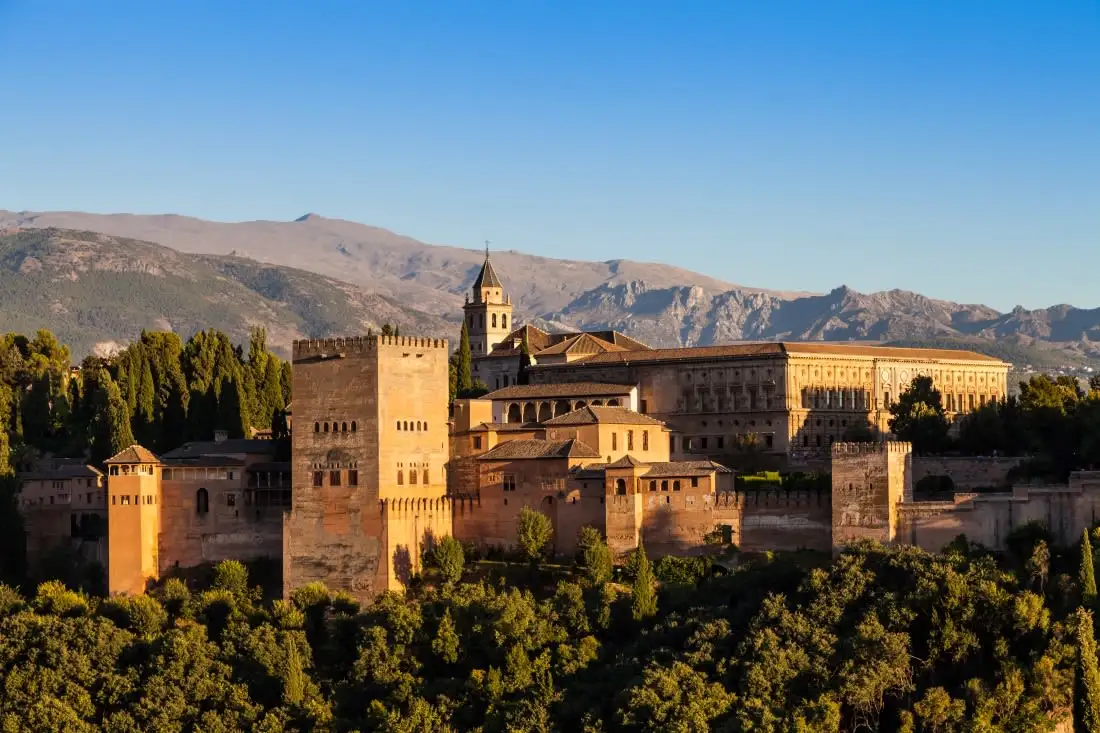
Granada
Granada is a city where history, culture, and natural beauty converge to create an unforgettable travel experience. At the heart of this enchanting destination lies the iconic Alhambra Palace, a breathtaking masterpiece of Moorish architecture that captures the essence of Spain's rich Islamic past. Wander through the Nasrid Palaces and be transported to a world of intricate designs and tranquil gardens. Explore the bustling streets of the Centro, where the Granada Cathedral stands as a monumental symbol of the city’s Catholic history. The nearby Albaicín district, with its narrow, winding streets, offers a glimpse into the daily life Granada’s Medieval past. Here, the Mirador de San Nicolás provides an amazing view of the Alhambra, especially magical at sunset when the palace glows against the backdrop of the Sierra Nevada mountains. Granada’s unique cuisine is a delightful fusion of Spanish and Moorish flavors, with tapas bars offering a taste of the city’s culinary traditions. Whether you’re savoring the local dishes, exploring historical sites, or simply enjoying the unique atmosphere, Granada promises a journey that’s as enriching as it is unforgettable.

Learn About Granada
Build Granada Trip
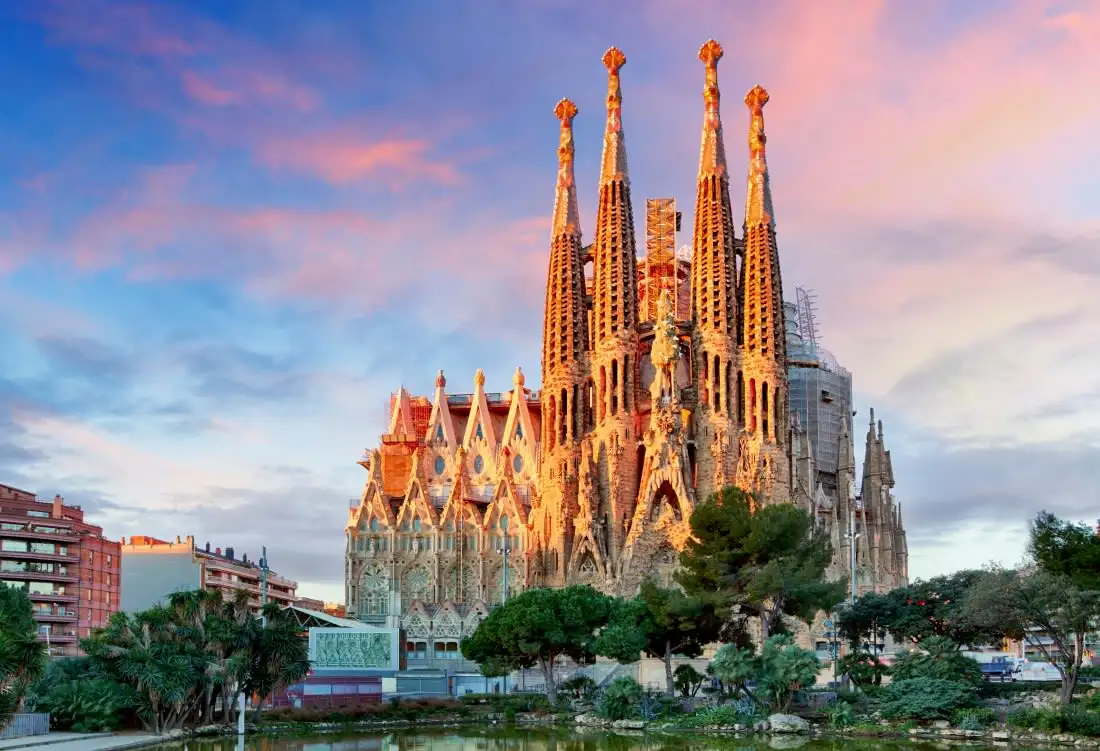
Barcelona
Barcelona, the cosmopolitan capital of Catalonia, is a city that dances to a rhythm of its own. Known for its architectural wonders and vibrant street life, this city is a tapestry of rich history and contemporary culture. Wander through its bustling streets and you'll feel the pulse of heritage and innovation beating as one. From the awe-inspiring Sagrada Familia to the colorful mosaics of Park Guell, Barcelona offers endless avenues to explore and discover. As the sun sets, the city transforms into a lively spectacle of lights and shadows, inviting you to indulge in its culinary delights and spirited nightlife. Whether you’re soaking up the Mediterranean sun on its beaches or exploring its Gothic quarters, Barcelona promises an unforgettable journey that will captivate your heart and stir your soul.

Learn About Barcelona
Build Barcelona Trip
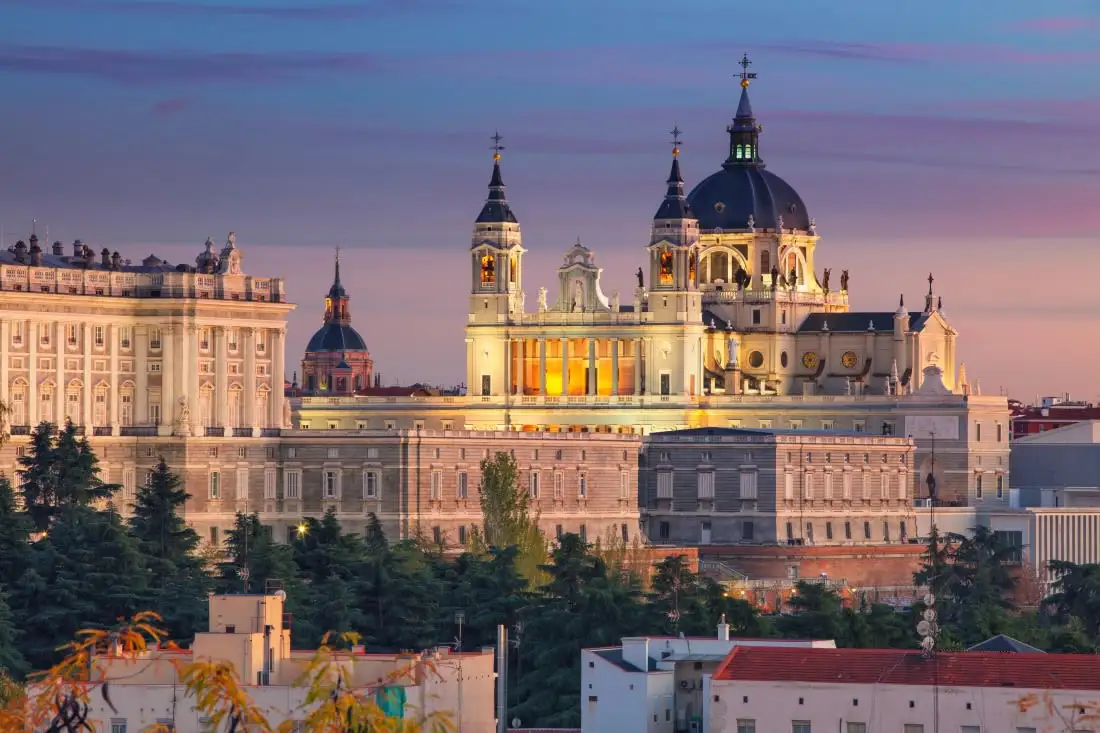
Madrid
What are the best Madrid recommendations for Madrid travel? Take two parts culture, two part history, douse it with art, sprinkle it all with lots of Spanish zest, and live vigorously: That's the recipe for Madrid, Spain's capital. Let Go Real be your guide to Madrid, the city alive with the rhythms of passionate flamenco on its cosmopolitan streets, inviting travelers into its warm embrace. Here, art enthusiasts can lose themselves in the hallowed halls of the Prado Museum, home to masterpieces by Velázquez, Goya, and El Greco, while the Reina Sofia and Thyssen-Bornemisza museums complete Madrid's famed Art Triangle, offering a journey through centuries of art history. The city's culinary scene is equally compelling, with tapas bars and bustling markets like Mercado San Miguel offering a taste of Spain's rich gastronomic heritage through an array of tapas, wines, and cheeses. Madrid's architectural splendor is evident in its royal palaces, ornate plazas, and expansive parks, such as the Retiro, a green oasis in the heart of the city where locals and tourists alike find respite by its serene lake. As night falls, Madrid's streets come alive with an infectious energy, from the historic tapas bars in the Latina district to the chic dancehalls in Malasaña and Chueca, reflecting the city's open-hearted spirit and its inhabitants' joie de vivre. With Go Real's Madrid sightseeing guide and using our Madrid tips, you will find the best place to bask in the sun at a lively terrace café, explore the treasures of the Hapsburg Madrid, or discover your own precious finds at Rastro's flea market. With our best Madrid travelguide, the city offers an endless array of experiences that beckon the curious traveler to taste its many charms.

Learn About Madrid
Build Madrid Trip
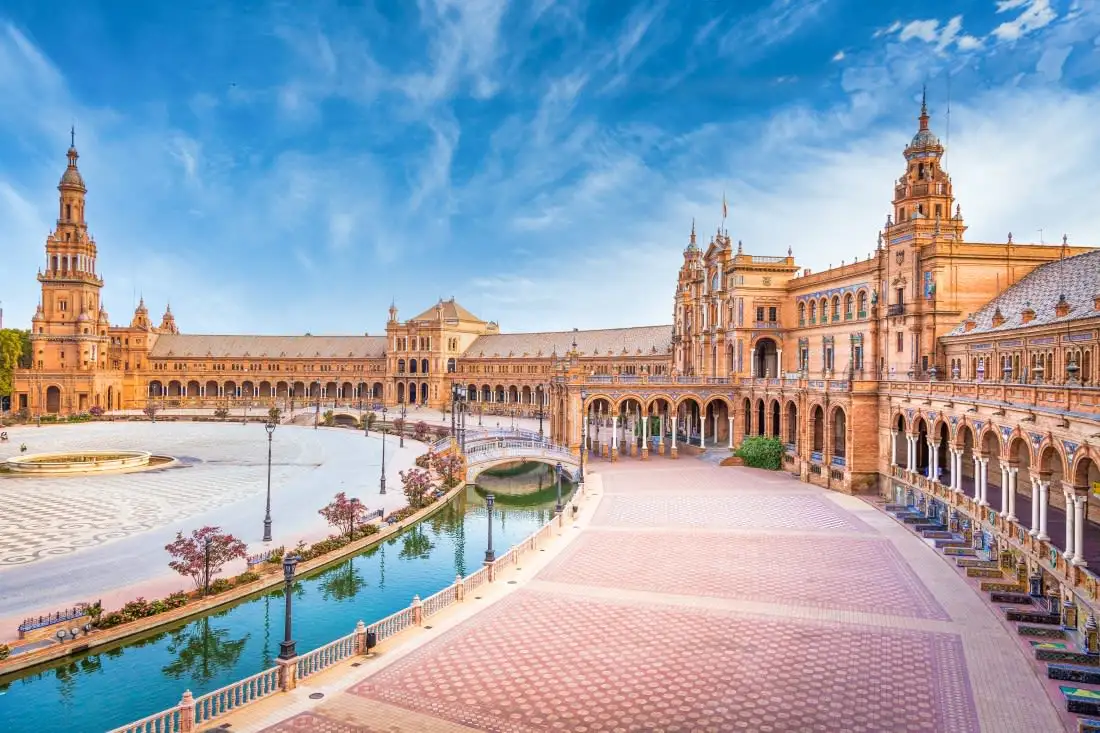
Seville
Seville, the capital of Spain's Andalusia region, is a city rich in history and culture. Architectural marvels like Plaza de España, Seville Cathedral, and the Alcazar reflect its storied past, while its vibrant cuisine and flamenco music showcase its lively present. Key landmarks include the Giralda, a minaret turned bell tower, and the bustling old town, filled with narrow streets, traditional tapas bars, and lively plazas. Whether exploring historical sites or savoring local flavors, Seville captivates with its spirited atmosphere and colorful heritage, making it a true center of Spanish culture and tradition.

Learn About Seville
Build Seville Trip

Paris
The magic of Paris is undeniable. This is the most romantic destination in Europe, and surely the number one bucket list destination of all time. If you want to say you've traveled, you have to visit Paris at least once. Along with classic must-sees like the Eiffel Tower and the Sacre-Coeur, there is so much to see and do in Paris that it helps to narrow it down by interest. Fashion and shopping enthusiast? Look no further than the Galeries Lafayette, Avenue des Champs-Élysées, or the Marais. Art aficionado? Once you're done with the Louvre, make a start on the Musée d'Orsay. History buffs won't be able to walk a block without uncovering a monument to Napoleon or Louis XIV. If you visit Paris with a foodie, be warned — you'll gaze in a lot of patisserie windows, and sample your weight in croissants. Because Paris always has so much on offer, it never grows old. At dusk, as you stroll the wide boulevards past Haussmann apartment buildings and sharply dressed Parisians, or gaze down at the city from the hill at Montmarte, you might find yourself saying 'Paris Je t' aime'. This is, after all, the City of Love.

Learn About Paris
Build Paris Trip

Aix en Provence
Aix en Provence is a warm city baked into the Provence-Alpes-Côte region of Southern France. Often referred to as simply ‘Aix’, this city is a starting point for traveling the Provencal region. Aix is set amongst a backdrop of rambling vineyards, quaint villages, and the imposing Sainte-Victoire mountain range. It’s no surprise that artists like Cézanne have devoted lifetimes to painting this landscape. Aromatic lavender fields in the north blossom once a year with a scent that defines the French countryside. Head south and you’ll find the rocky Mediterranean shore with dramatic Calanques cliffs and clear blue waters. With the sun out nearly all year round, locals live the epitome of the Mediterranean lifestyle. Wander through narrow medieval streets, shop at lively marketplaces, and enjoy a glass of rosé on a cafe terrace beneath the gentle Provencal sun. From old-world architecture and bubbling fountains to refined galleries and leafy parks, this leisurely city has everything you could ask of a French vacation.

Learn About Aix en Provence
Build Aix en Provence Trip

Granada
Granada is a city where history, culture, and natural beauty converge to create an unforgettable travel experience. At the heart of this enchanting destination lies the iconic Alhambra Palace, a breathtaking masterpiece of Moorish architecture that captures the essence of Spain's rich Islamic past. Wander through the Nasrid Palaces and be transported to a world of intricate designs and tranquil gardens. Explore the bustling streets of the Centro, where the Granada Cathedral stands as a monumental symbol of the city’s Catholic history. The nearby Albaicín district, with its narrow, winding streets, offers a glimpse into the daily life Granada’s Medieval past. Here, the Mirador de San Nicolás provides an amazing view of the Alhambra, especially magical at sunset when the palace glows against the backdrop of the Sierra Nevada mountains. Granada’s unique cuisine is a delightful fusion of Spanish and Moorish flavors, with tapas bars offering a taste of the city’s culinary traditions. Whether you’re savoring the local dishes, exploring historical sites, or simply enjoying the unique atmosphere, Granada promises a journey that’s as enriching as it is unforgettable.

Learn About Granada
Build Granada Trip

Barcelona
Barcelona, the cosmopolitan capital of Catalonia, is a city that dances to a rhythm of its own. Known for its architectural wonders and vibrant street life, this city is a tapestry of rich history and contemporary culture. Wander through its bustling streets and you'll feel the pulse of heritage and innovation beating as one. From the awe-inspiring Sagrada Familia to the colorful mosaics of Park Guell, Barcelona offers endless avenues to explore and discover. As the sun sets, the city transforms into a lively spectacle of lights and shadows, inviting you to indulge in its culinary delights and spirited nightlife. Whether you’re soaking up the Mediterranean sun on its beaches or exploring its Gothic quarters, Barcelona promises an unforgettable journey that will captivate your heart and stir your soul.

Learn About Barcelona
Build Barcelona Trip

Madrid
What are the best Madrid recommendations for Madrid travel? Take two parts culture, two part history, douse it with art, sprinkle it all with lots of Spanish zest, and live vigorously: That's the recipe for Madrid, Spain's capital. Let Go Real be your guide to Madrid, the city alive with the rhythms of passionate flamenco on its cosmopolitan streets, inviting travelers into its warm embrace. Here, art enthusiasts can lose themselves in the hallowed halls of the Prado Museum, home to masterpieces by Velázquez, Goya, and El Greco, while the Reina Sofia and Thyssen-Bornemisza museums complete Madrid's famed Art Triangle, offering a journey through centuries of art history. The city's culinary scene is equally compelling, with tapas bars and bustling markets like Mercado San Miguel offering a taste of Spain's rich gastronomic heritage through an array of tapas, wines, and cheeses. Madrid's architectural splendor is evident in its royal palaces, ornate plazas, and expansive parks, such as the Retiro, a green oasis in the heart of the city where locals and tourists alike find respite by its serene lake. As night falls, Madrid's streets come alive with an infectious energy, from the historic tapas bars in the Latina district to the chic dancehalls in Malasaña and Chueca, reflecting the city's open-hearted spirit and its inhabitants' joie de vivre. With Go Real's Madrid sightseeing guide and using our Madrid tips, you will find the best place to bask in the sun at a lively terrace café, explore the treasures of the Hapsburg Madrid, or discover your own precious finds at Rastro's flea market. With our best Madrid travelguide, the city offers an endless array of experiences that beckon the curious traveler to taste its many charms.

Learn About Madrid
Build Madrid Trip

Seville
Seville, the capital of Spain's Andalusia region, is a city rich in history and culture. Architectural marvels like Plaza de España, Seville Cathedral, and the Alcazar reflect its storied past, while its vibrant cuisine and flamenco music showcase its lively present. Key landmarks include the Giralda, a minaret turned bell tower, and the bustling old town, filled with narrow streets, traditional tapas bars, and lively plazas. Whether exploring historical sites or savoring local flavors, Seville captivates with its spirited atmosphere and colorful heritage, making it a true center of Spanish culture and tradition.

Learn About Seville
Build Seville Trip
prev
next


 Map of Your Itinerary Route
Map of Your Itinerary Route
Zoom In to the cities to see your itinerary in more detail


 4.8
4.8 






